Unit5 What an adventure Starting out & Understanding ideas—Reading comprehension课件(共32张PPT)
文档属性
| 名称 | Unit5 What an adventure Starting out & Understanding ideas—Reading comprehension课件(共32张PPT) | 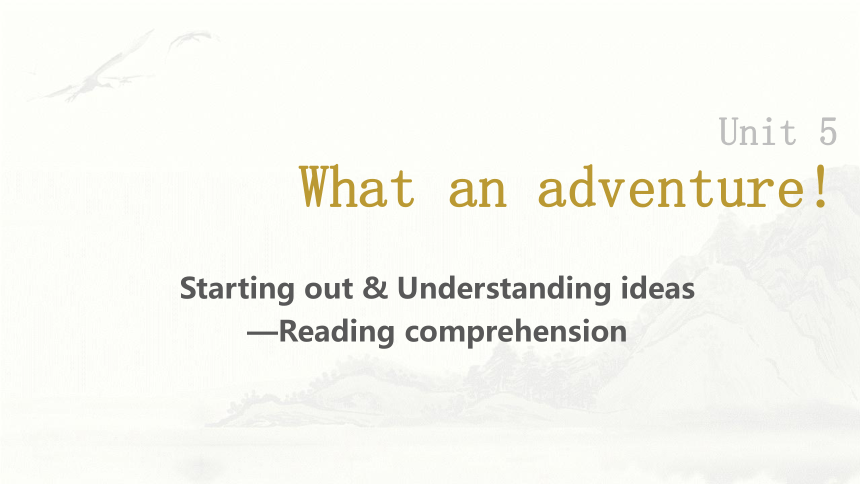 | |
| 格式 | pptx | ||
| 文件大小 | 4.5MB | ||
| 资源类型 | 教案 | ||
| 版本资源 | 外研版(2019) | ||
| 科目 | 英语 | ||
| 更新时间 | 2023-10-15 11:13:10 | ||
图片预览

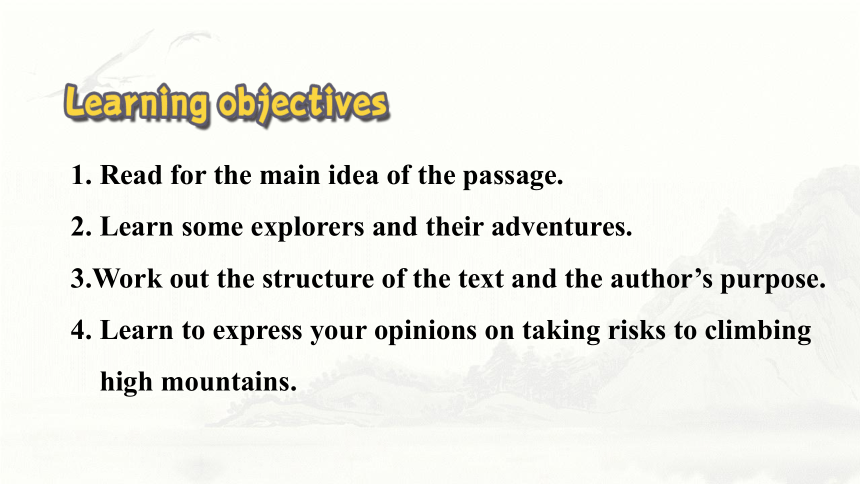
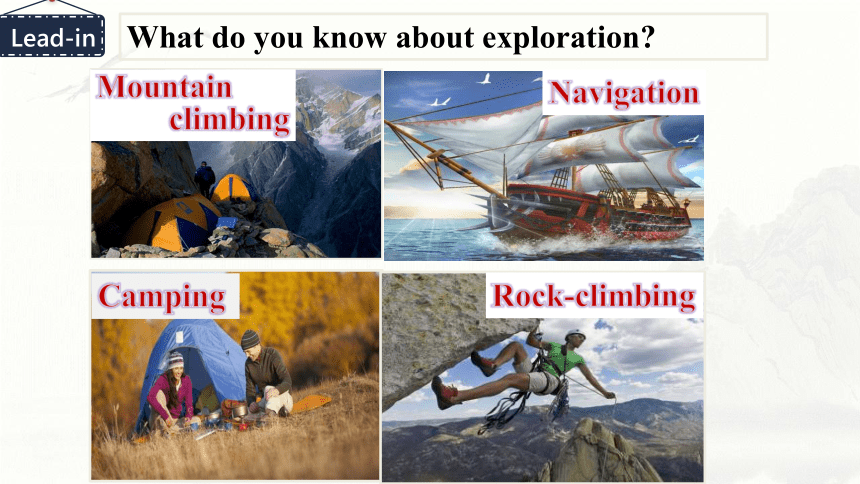
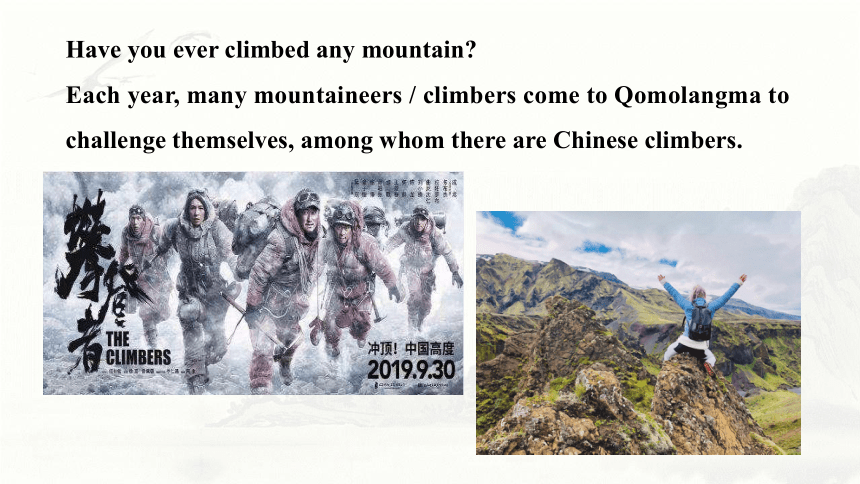
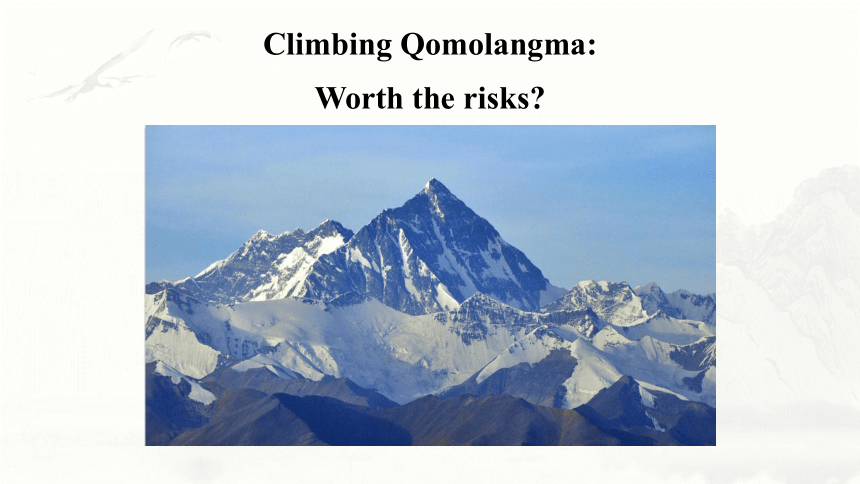
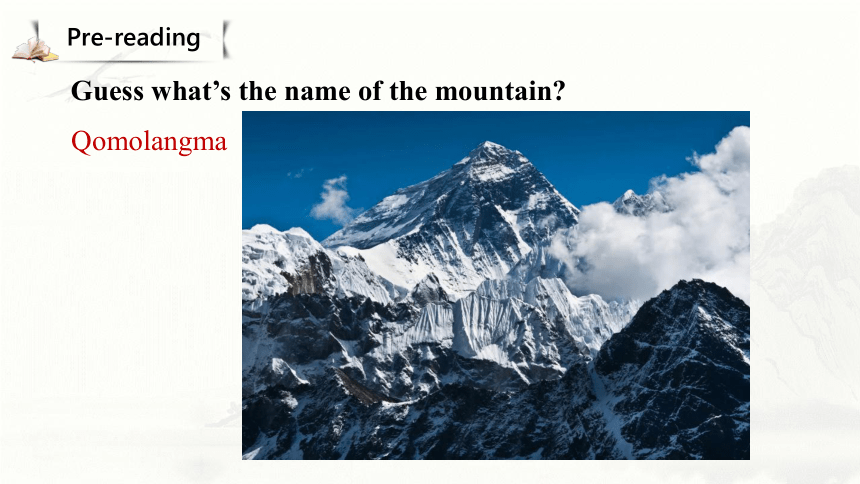
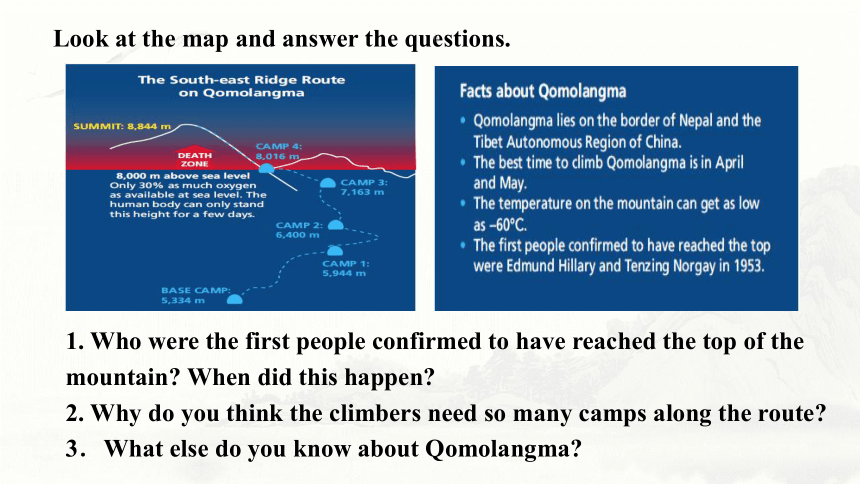
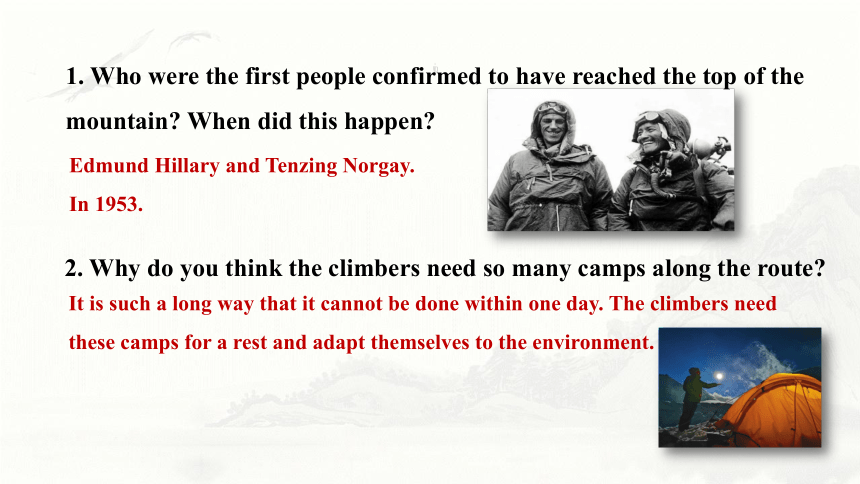
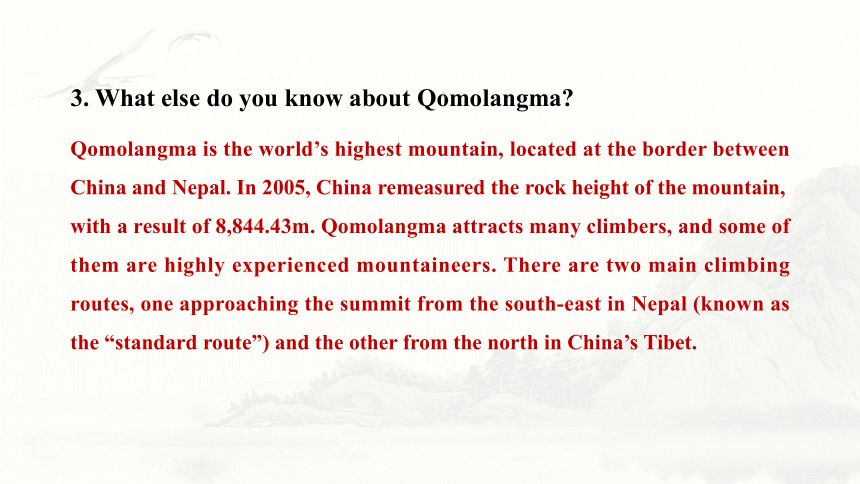
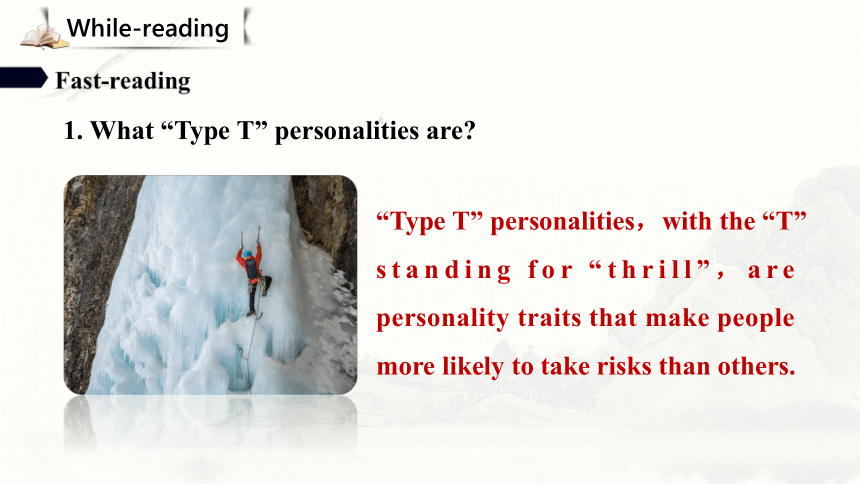
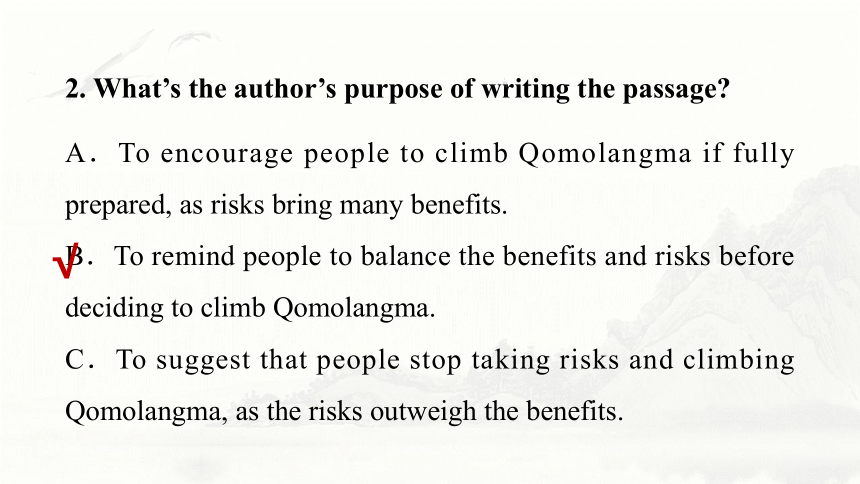
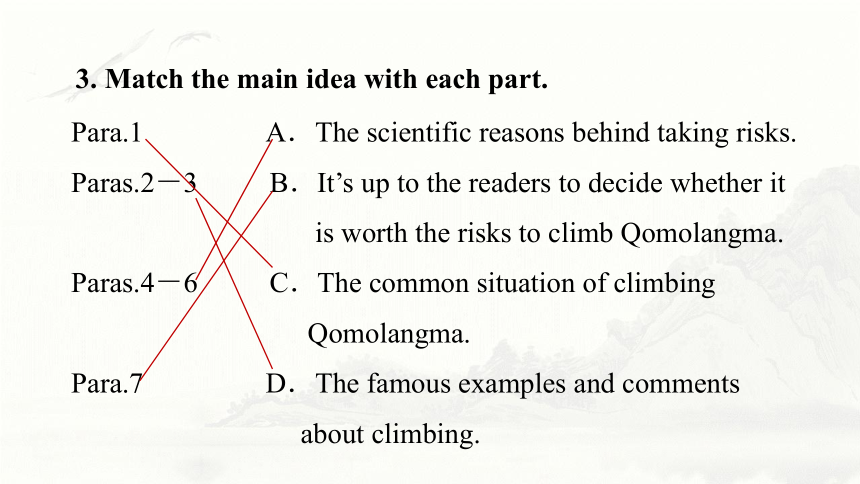
文档简介
(共32张PPT)
Unit 5
What an adventure!
Starting out & Understanding ideas
—Reading comprehension
1. Read for the main idea of the passage.
2. Learn some explorers and their adventures.
3.Work out the structure of the text and the author’s purpose.
4. Learn to express your opinions on taking risks to climbing
high mountains.
What do you know about exploration
Mountain
climbing
Navigation
Camping
Rock-climbing
Lead-in
Have you ever climbed any mountain
Each year, many mountaineers / climbers come to Qomolangma to challenge themselves, among whom there are Chinese climbers.
Climbing Qomolangma:
Worth the risks
Guess what’s the name of the mountain
Qomolangma
Pre-reading
Look at the map and answer the questions.
1. Who were the first people confirmed to have reached the top of the mountain When did this happen
2. Why do you think the climbers need so many camps along the route
3.What else do you know about Qomolangma
Edmund Hillary and Tenzing Norgay.
In 1953.
It is such a long way that it cannot be done within one day. The climbers need these camps for a rest and adapt themselves to the environment.
1. Who were the first people confirmed to have reached the top of the mountain When did this happen
2. Why do you think the climbers need so many camps along the route
3. What else do you know about Qomolangma
Qomolangma is the world’s highest mountain, located at the border between China and Nepal. In 2005, China remeasured the rock height of the mountain, with a result of 8,844.43m. Qomolangma attracts many climbers, and some of them are highly experienced mountaineers. There are two main climbing routes, one approaching the summit from the south east in Nepal (known as the “standard route”) and the other from the north in China’s Tibet.
1. What “Type T” personalities are
“Type T” personalities,with the “T” standing for “thrill”,are personality traits that make people more likely to take risks than others.
While-reading
2. What’s the author’s purpose of writing the passage
A.To encourage people to climb Qomolangma if fully prepared, as risks bring many benefits.
B.To remind people to balance the benefits and risks before deciding to climb Qomolangma.
C.To suggest that people stop taking risks and climbing Qomolangma, as the risks outweigh the benefits.
√
3. Match the main idea with each part.
Para.1 A.The scientific reasons behind taking risks.
Paras.2-3 B.It’s up to the readers to decide whether it
is worth the risks to climb Qomolangma.
Paras.4-6 C.The common situation of climbing
Qomolangma.
Para.7 D.The famous examples and comments
about climbing.
1. What does the author try to tell us in Para.1
A.The great difficulty in climbing Qomolangma.
B.Two different kinds of Qomolangma climbers.
C.People’s strong desire to climb Qomolangma.
D.The great risks of climbing Qomolangma.
Ⅰ. Read Para.1 carefully and answer the questions.
2. What challenges do the climbers face
Crowds, discomfort, danger; extreme cold, low air pressure; becoming sick and losing their lives.
√
Careful-reading
Why do people climb Qomolangma
George Mallory What people get from this adventure is just __________. People eat and make money to be able to __________, not the other way round.
Alan Arnette Each person has a(n) ___________________ reason for climbing a mountain. It forces people to______________ themselves. To succeed, people must have the physical as well as _______________.
sheer joy
enjoy life
important and unique
look deep inside
mental toughness
Ⅱ. Read Paras.2-3 and finish the tasks.
2.What do George Mallory and Alan Arnette have in common
A.They both succeeded in climbing Qomolangma.
B.They both climbed many other high mountains afterwards.
C.They both found the risks of climbing worth taking.
D.They both found the real meaning of life and enjoyed it.
√
3. What can be inferred from George Mallory’s words in Para. 2
A.People care much about eating and making money.
B.It’s hard to find a reason for climbing Qomolangma.
C.Nothing but joy can be felt in climbing Qomolangma.
D.Climbing Qomolangma is a journey of gaining the pleasure of life.
√
4. What is the most important and unique for us when we want to give up
A.The reason to turn around.
B.Looking inside ourselves.
C.The physical and mental toughness.
D.Keeping focus on the climbing.
√
Scientific reasons
Risk-taking may be part of _____________. People who are more likely to __________ have “Type T” personalities. Research also suggests that our desire to seek risks can be connected to how much we expect to ____________________.
human nature
take risks
benefit from the result
Ⅲ. Read Paras.4-6 and finish the tasks.
2. Who are the people with “Type T” personalities
A. Passengers on the plane.
B. People driving cars on the road.
C. People making money to live.
D. People jumping out of planes.
√
3. How can we measure the action of climbing Qomolangma
A. By taking more risks and climbing more.
B. By balancing the benefits and the result.
C. By being an expert and expecting not to die.
D. By equipping yourself with “Type T” personalities.
√
With this in mind, are the benefits of climbing Qomolangma worth the risks It’s totally____________.
2. After reading the whole passage, what’s your idea?Worth
the risks
up to you
Ⅳ. Read Para.7 and finish the tasks.
A possible answer:
I think it is worth the risks. On one hand, climbing the Qomolangma means self- challenge, which can train our strong will. On the other hand, its value lies in people’s conquering difficulty one after another.
Paras. 4–5: Perhaps part of human nature:__________
____________
Climbing Qomolangma: worth the risks
Introducing the topic
Para.1:______________________________________.
Climbing Qomolangma is a special experience
Reasons for the climbers’ risk-taking
Subjective reasons
Scientific reasons
Para. 2 : George Mallory:_____________________
Para. 6:______________________________________.
just pure joy; enjoy life
“Type T”
man’s desire to expect to benefit from the result
Para. 3: Alan Arnette: It forces people to look inside themselves and figure out ______________________
__________________________.
if they really have the
personalities
physical and mental toughness
Ⅴ. Finish the tasks and retell the passage.
Conclusion
Para 7: It’s up to the readers to decide _______________
_______________________.
whether it is worth
the risks to climb Qomolangma
Post-reading
Discussion
Do you agree with Mallory’s and Arnette’s ideas Why
(Critical thinking)
2. If you were given the chance, would you like to climb Qomolangma Why or why not?(Creative thinking)
Climbing Qomolangma is an experience 1._________(include) crowds, discomfort and danger. Many climbers would become sick due to the extreme cold and low air pressure and a few would even lose 2._____(they) lives. As for George Mallory, climbing Qomolangma is 3.____experience which makes people feel powerful. 4.______ they get from the adventure is just sheer joy. Meanwhile, Alan Arnette thinks climbing the mountains forces people 5.____________(look) deep inside themselves. People must have the physical and mental 6.___________(tough) to succeed.
including
their
What
to look
Summary
an
toughness
Recent 7._______(study) indicate that taking risks may be part of human nature, with some of us 8.___________(likely) to take risks than others. Psychologist Frank Farley refers to the personalities of these people 9.____ “Type T”, with the “T” standing for “thrill”.Research also suggests that our desire to seek risks can 10.____________(connect) to how much we expect to benefit from the result.
studies
more likely
as
be connected
Last year, hundreds of people spent good money on an experience that they knew would include crowds, discomfort and danger. Many would become sick, due to the extreme cold and low air pressure, and a few would even lose their lives. Yet, despite all this, by the end of the trip many were already planning to return. For these people,
climbing Qomolangma is an experience like no other, making some feel weak and others, powerful.
Analyze the key points of the text
Para. 1
that引导定语从句
spend money on...“在······上花钱”
失去生命
动名词作主语
现在分词短语作结果状语
“因为,由于”,后接原因状语
British mountain climber George Mallory wrote of climbing Qomolangma, “What we get from this adventure is just sheer joy... We do not live to eat and make money. We eat and make money to be able to enjoy life. That is what life means and what life is for.” Sadly, Mallory would die on the mountain in 1924, although his body would not be found until many years later. It is still not known if he succeeded in reaching the top of Qomolangma before it took his life.
Para. 2
what引导主语从句
and 连接的并列状语
主系表结构中and 连接两个并列的表语从句
although引导让步状语从句
not...until...“直到······才······”
it作形式主语,if引导的从句是真正的主语
before引导时间状语从句
In 2011, words similar to those of Mallory were spoken by American mountain climber Alan Arnette, who climbed Qomolangma in that year and was going to climb other high mountains around the world. “It brings into focus what’s important to you.” He added, “There are a thousand reasons to turn around and only one to keep going. You really have to focus on the one reason that’s most important and unique to you. It forces you to look deep inside yourself and figure out
if you really have the physical, as well as mental, toughness to push when you want to stop.”
Para. 3
be similar to与······相似
代词,代指words
who引导非限制性定语从句
“使······成为焦点”
what引导宾语从句
“集中注意力于······”
that引导定语从句,在从句中作主语,不可省略
理解,弄明白
if引导宾语从句
“和,也 ”,表并列
when引导时间状语从句
With the majority of attempts to climb Qomolangma resulting either in total success or failure, is there also a scientific reason behind this risk-taking Recent studies indicate that risk-taking may be part of human nature, with some of us more likely to take risks than others. Psychologist Frank Farley has spent years studying people who jump out of planes and drive fast cars, as well as those who climb Qomolangma. He refers to the personalities of these people as “Type T”, with the “T” standing for “thrill”.
Para. 4
with的复合宾语结构
或者······或者······
宾语
(
)
(
)
宾语补足语
that引导宾语从句
be likely to do sth意为“有可能做某事”
spend time (in)dong 花时间做某事
who引导定语从句修饰people
those代词,who引导定语从句
refer to...as...把······称作······
代表
Speaking to the LA Times about the “Type T” personalities, Farley said, “They’ll say, ‘I’m not taking risks, I’m an expert...’ They don’t want to die and they don’t expect to die.”
冒险
期待去做
Para. 5
Research also suggests that our desire to seek risks can be connected to how much we expect to benefit from the result.
With this in mind, are the benefits of climbing Qomolangma worth the risks It’s totally up to you.
暗示,表明
that 引导宾语从句
to do 不定式作后置定语
how much引导宾语从句
be up to you取决于你
Paras. 6-7
benefit from...从······中受益
Write a short passage about your adventure experience or dream.
Homework
Unit 5
What an adventure!
Starting out & Understanding ideas
—Reading comprehension
1. Read for the main idea of the passage.
2. Learn some explorers and their adventures.
3.Work out the structure of the text and the author’s purpose.
4. Learn to express your opinions on taking risks to climbing
high mountains.
What do you know about exploration
Mountain
climbing
Navigation
Camping
Rock-climbing
Lead-in
Have you ever climbed any mountain
Each year, many mountaineers / climbers come to Qomolangma to challenge themselves, among whom there are Chinese climbers.
Climbing Qomolangma:
Worth the risks
Guess what’s the name of the mountain
Qomolangma
Pre-reading
Look at the map and answer the questions.
1. Who were the first people confirmed to have reached the top of the mountain When did this happen
2. Why do you think the climbers need so many camps along the route
3.What else do you know about Qomolangma
Edmund Hillary and Tenzing Norgay.
In 1953.
It is such a long way that it cannot be done within one day. The climbers need these camps for a rest and adapt themselves to the environment.
1. Who were the first people confirmed to have reached the top of the mountain When did this happen
2. Why do you think the climbers need so many camps along the route
3. What else do you know about Qomolangma
Qomolangma is the world’s highest mountain, located at the border between China and Nepal. In 2005, China remeasured the rock height of the mountain, with a result of 8,844.43m. Qomolangma attracts many climbers, and some of them are highly experienced mountaineers. There are two main climbing routes, one approaching the summit from the south east in Nepal (known as the “standard route”) and the other from the north in China’s Tibet.
1. What “Type T” personalities are
“Type T” personalities,with the “T” standing for “thrill”,are personality traits that make people more likely to take risks than others.
While-reading
2. What’s the author’s purpose of writing the passage
A.To encourage people to climb Qomolangma if fully prepared, as risks bring many benefits.
B.To remind people to balance the benefits and risks before deciding to climb Qomolangma.
C.To suggest that people stop taking risks and climbing Qomolangma, as the risks outweigh the benefits.
√
3. Match the main idea with each part.
Para.1 A.The scientific reasons behind taking risks.
Paras.2-3 B.It’s up to the readers to decide whether it
is worth the risks to climb Qomolangma.
Paras.4-6 C.The common situation of climbing
Qomolangma.
Para.7 D.The famous examples and comments
about climbing.
1. What does the author try to tell us in Para.1
A.The great difficulty in climbing Qomolangma.
B.Two different kinds of Qomolangma climbers.
C.People’s strong desire to climb Qomolangma.
D.The great risks of climbing Qomolangma.
Ⅰ. Read Para.1 carefully and answer the questions.
2. What challenges do the climbers face
Crowds, discomfort, danger; extreme cold, low air pressure; becoming sick and losing their lives.
√
Careful-reading
Why do people climb Qomolangma
George Mallory What people get from this adventure is just __________. People eat and make money to be able to __________, not the other way round.
Alan Arnette Each person has a(n) ___________________ reason for climbing a mountain. It forces people to______________ themselves. To succeed, people must have the physical as well as _______________.
sheer joy
enjoy life
important and unique
look deep inside
mental toughness
Ⅱ. Read Paras.2-3 and finish the tasks.
2.What do George Mallory and Alan Arnette have in common
A.They both succeeded in climbing Qomolangma.
B.They both climbed many other high mountains afterwards.
C.They both found the risks of climbing worth taking.
D.They both found the real meaning of life and enjoyed it.
√
3. What can be inferred from George Mallory’s words in Para. 2
A.People care much about eating and making money.
B.It’s hard to find a reason for climbing Qomolangma.
C.Nothing but joy can be felt in climbing Qomolangma.
D.Climbing Qomolangma is a journey of gaining the pleasure of life.
√
4. What is the most important and unique for us when we want to give up
A.The reason to turn around.
B.Looking inside ourselves.
C.The physical and mental toughness.
D.Keeping focus on the climbing.
√
Scientific reasons
Risk-taking may be part of _____________. People who are more likely to __________ have “Type T” personalities. Research also suggests that our desire to seek risks can be connected to how much we expect to ____________________.
human nature
take risks
benefit from the result
Ⅲ. Read Paras.4-6 and finish the tasks.
2. Who are the people with “Type T” personalities
A. Passengers on the plane.
B. People driving cars on the road.
C. People making money to live.
D. People jumping out of planes.
√
3. How can we measure the action of climbing Qomolangma
A. By taking more risks and climbing more.
B. By balancing the benefits and the result.
C. By being an expert and expecting not to die.
D. By equipping yourself with “Type T” personalities.
√
With this in mind, are the benefits of climbing Qomolangma worth the risks It’s totally____________.
2. After reading the whole passage, what’s your idea?Worth
the risks
up to you
Ⅳ. Read Para.7 and finish the tasks.
A possible answer:
I think it is worth the risks. On one hand, climbing the Qomolangma means self- challenge, which can train our strong will. On the other hand, its value lies in people’s conquering difficulty one after another.
Paras. 4–5: Perhaps part of human nature:__________
____________
Climbing Qomolangma: worth the risks
Introducing the topic
Para.1:______________________________________.
Climbing Qomolangma is a special experience
Reasons for the climbers’ risk-taking
Subjective reasons
Scientific reasons
Para. 2 : George Mallory:_____________________
Para. 6:______________________________________.
just pure joy; enjoy life
“Type T”
man’s desire to expect to benefit from the result
Para. 3: Alan Arnette: It forces people to look inside themselves and figure out ______________________
__________________________.
if they really have the
personalities
physical and mental toughness
Ⅴ. Finish the tasks and retell the passage.
Conclusion
Para 7: It’s up to the readers to decide _______________
_______________________.
whether it is worth
the risks to climb Qomolangma
Post-reading
Discussion
Do you agree with Mallory’s and Arnette’s ideas Why
(Critical thinking)
2. If you were given the chance, would you like to climb Qomolangma Why or why not?(Creative thinking)
Climbing Qomolangma is an experience 1._________(include) crowds, discomfort and danger. Many climbers would become sick due to the extreme cold and low air pressure and a few would even lose 2._____(they) lives. As for George Mallory, climbing Qomolangma is 3.____experience which makes people feel powerful. 4.______ they get from the adventure is just sheer joy. Meanwhile, Alan Arnette thinks climbing the mountains forces people 5.____________(look) deep inside themselves. People must have the physical and mental 6.___________(tough) to succeed.
including
their
What
to look
Summary
an
toughness
Recent 7._______(study) indicate that taking risks may be part of human nature, with some of us 8.___________(likely) to take risks than others. Psychologist Frank Farley refers to the personalities of these people 9.____ “Type T”, with the “T” standing for “thrill”.Research also suggests that our desire to seek risks can 10.____________(connect) to how much we expect to benefit from the result.
studies
more likely
as
be connected
Last year, hundreds of people spent good money on an experience that they knew would include crowds, discomfort and danger. Many would become sick, due to the extreme cold and low air pressure, and a few would even lose their lives. Yet, despite all this, by the end of the trip many were already planning to return. For these people,
climbing Qomolangma is an experience like no other, making some feel weak and others, powerful.
Analyze the key points of the text
Para. 1
that引导定语从句
spend money on...“在······上花钱”
失去生命
动名词作主语
现在分词短语作结果状语
“因为,由于”,后接原因状语
British mountain climber George Mallory wrote of climbing Qomolangma, “What we get from this adventure is just sheer joy... We do not live to eat and make money. We eat and make money to be able to enjoy life. That is what life means and what life is for.” Sadly, Mallory would die on the mountain in 1924, although his body would not be found until many years later. It is still not known if he succeeded in reaching the top of Qomolangma before it took his life.
Para. 2
what引导主语从句
and 连接的并列状语
主系表结构中and 连接两个并列的表语从句
although引导让步状语从句
not...until...“直到······才······”
it作形式主语,if引导的从句是真正的主语
before引导时间状语从句
In 2011, words similar to those of Mallory were spoken by American mountain climber Alan Arnette, who climbed Qomolangma in that year and was going to climb other high mountains around the world. “It brings into focus what’s important to you.” He added, “There are a thousand reasons to turn around and only one to keep going. You really have to focus on the one reason that’s most important and unique to you. It forces you to look deep inside yourself and figure out
if you really have the physical, as well as mental, toughness to push when you want to stop.”
Para. 3
be similar to与······相似
代词,代指words
who引导非限制性定语从句
“使······成为焦点”
what引导宾语从句
“集中注意力于······”
that引导定语从句,在从句中作主语,不可省略
理解,弄明白
if引导宾语从句
“和,也 ”,表并列
when引导时间状语从句
With the majority of attempts to climb Qomolangma resulting either in total success or failure, is there also a scientific reason behind this risk-taking Recent studies indicate that risk-taking may be part of human nature, with some of us more likely to take risks than others. Psychologist Frank Farley has spent years studying people who jump out of planes and drive fast cars, as well as those who climb Qomolangma. He refers to the personalities of these people as “Type T”, with the “T” standing for “thrill”.
Para. 4
with的复合宾语结构
或者······或者······
宾语
(
)
(
)
宾语补足语
that引导宾语从句
be likely to do sth意为“有可能做某事”
spend time (in)dong 花时间做某事
who引导定语从句修饰people
those代词,who引导定语从句
refer to...as...把······称作······
代表
Speaking to the LA Times about the “Type T” personalities, Farley said, “They’ll say, ‘I’m not taking risks, I’m an expert...’ They don’t want to die and they don’t expect to die.”
冒险
期待去做
Para. 5
Research also suggests that our desire to seek risks can be connected to how much we expect to benefit from the result.
With this in mind, are the benefits of climbing Qomolangma worth the risks It’s totally up to you.
暗示,表明
that 引导宾语从句
to do 不定式作后置定语
how much引导宾语从句
be up to you取决于你
Paras. 6-7
benefit from...从······中受益
Write a short passage about your adventure experience or dream.
Homework
